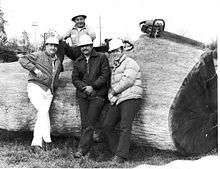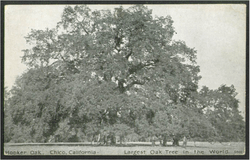Hooker Oak
| Hooker Oak | |
|---|---|
|
Postcard featuring the Hooker Oak circa 1910 | |
| Location | Bidwell Park, Chico, California |
| Coordinates | 39°44′18″N 121°49′31″W / 39.738333°N 121.825278°WCoordinates: 39°44′18″N 121°49′31″W / 39.738333°N 121.825278°W |
| Reference no. | 313[1] |
 Location of Hooker Oak in California | |
Hooker Oak was an extremely large valley oak tree (Quercus lobata) in Chico, California. Amateur botanist and local socialite Annie Bidwell, whose husband had founded Chico, named the tree in 1887 after English botanist and Director of the Royal Botanical Gardens Sir Joseph Dalton Hooker. It was featured in the 1938 film The Adventures of Robin Hood starring Eroll Flynn. The tree fell in 1977 and portions of the wood was later milled for use by local artisans.
Discovery
Upon first seeing the tree in 1872, Hooker declared the tree to be the largest of its species in the known world.[2] Since then other valley oaks have been found of similar size. On January 7, 1958, the Sacramento Bee reported that in 1921 the Hooker Oak was over 110 ft (34 m) tall and estimated that 7,885 people could stand under its canopy assuming 2 sq ft (0.2 m2) per person.
Death
When it fell on May 1, 1977, it was nearly a hundred feet tall (30 m) and at eight feet (2.4 m) from the ground, 29 feet (8.8 m) in circumference. The largest branch measured 111 feet (33.6 m) from trunk to tip and the circumference of outside branches was nearly five hundred feet (150 m). Its age had been estimated at a thousand years, but on its demise it was found to be two trees, of 325 years each which had long ago grown into one.
Disposition

For three years after falling, the tree lay on the ground while city leaders struggled to finally determine its fate. In the spring of 1980, the City of Chico commissioned Cal Oak Lumber Company to remove and reclaim sound portions of the tree at Cal Oak's Oroville hardwood plant. They were allowed to retain some of the wood as compensation. After milling the oak, Cal Oak arranged for the lumber to be dried at the University of California's Forest Products Laboratory.
Cal Oak set up a program using local artisans as well as the work training centers for the handicapped to produce a limited number of artistically designed items from its share of the tree. Many of these were given to various institutions, which included the Royal Botanical Gardens in London, the Butte County Historical Society, Bidwell Mansion, Sacramento Valley Museum, Butte College, California State University, Chico, and the University of California at Berkeley. The Royal Botanical Gardens also received acorns from the original tree in 1981 and planted them in their gardens.
Characteristics
Personnel at both Cal Oak and University of California Berkeley Forestry Lab became intrigued with the lumber. The wood turned out to be as remarkable as was the tree. In order to support its immense crown, the tree grew an abnormal portion of support wood on the upper side of its limbs and stems. This type wood is known as "tension wood" and helped provide the tree with an unbelievable high density: .88 specific gravity, roughly 50% heavier than surrounding oaks. This together with other special characteristics, provided the wood with its unique grain and character, and the tree, apparently with its longevity.
In popular culture
The gavel used at City Council meetings by the mayor of Chico was made from the Hooker Oak. The public benches in the lobby of the Chico City Council Chambers were made out of Hooker Oak wood by local artist Paul Atkins.
The Hooker Oak was featured Warner Brothers Studio's film The Adventures of Robin Hood (1938). Errol Flynn as Robin Hood forms his outlaw band beside the tree (called the "Gallows Oak" in the film).
The location of the tree is registered as a California Historical Landmark[1] and can be found in Bidwell Park. A booklet, "The History of the Hooker Oak" was written by Debra Moon for the City Of Chico Bidwell Park Centennial Hooker Oak Bench Project and printed in July 2005.
References
| Wikimedia Commons has media related to Hooker Oak. |
- 1 2 "Hooker Oak". Office of Historic Preservation, California State Parks. Retrieved 2012-04-30.
- ↑ "Sycamore is largest tree for hardwood". The Pittsburgh Press. Jan 24, 1916. p. 3. Retrieved 15 October 2015.
